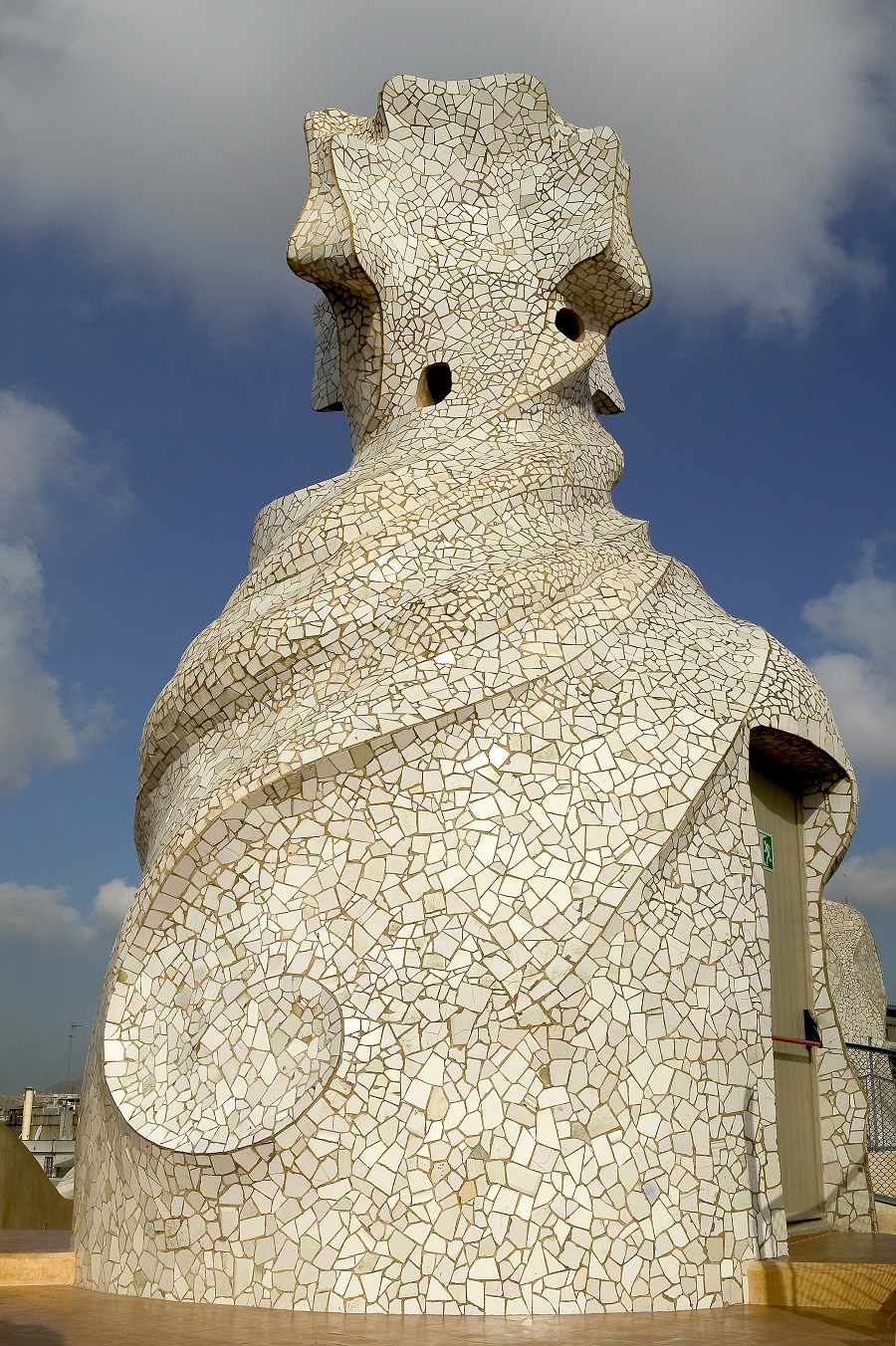 |
| Antoni Gaudi's La Pedrera is one of his Barcelona masterpieces, a commission done for a pair of wealthy patrons who gave his unlimited artistic license. It is highly informed by nature. |
ARCHITECT'S IMAGINATION AND REVERENCE FOR NATURE HIGHLIGHT HIS 'LA PEDRERA,' IN BARCELONA
PHOTOS By BRUCE KELLER
 |
| Bruce Keller and Christene "Cookie" Meyers enjoy a moment of reflection outside Gaudi's Casa Mila, or "La Pedrera." |
 |
| The curved "attic" of Casa Mila is a museum on its own, with drawings, exhibits and models showing the profound influence nature had on Gaudi's life's work. |
WHEN THE brilliant architect Antoni Gaudi was struck by a tram on a pleasant June morning in 1926, he had no identification on his body. He rested unknown in a morgue for several days while officials tried to identify him. The great man was walking to his daily confessional at a nearby church when tragedy befell him.
When it was discovered that he was an internationally known architect -- one of the city's proudest sons -- he was mourned for weeks. Today, he is still celebrated as a genius. His work is acclaimed for its grace, originality and connection to nature, evident in its nods to the sea and its creatures, and to birds, flowers, trees, and all living things.
WE SPENT a recent week marveling at Gaudi's wondrous accomplishments. He viewed the natural world as perfect, a creation from which he drew his inspiration. This connection is visible in all his work but critics believe it is most present in his masterpiece, Barcelona's famous Sagrada Familia. The cathedral has been in constant development since its foundation was laid in 1883. Its completion -- many times delayed -- is now scheduled for 2026, on the 100th anniversary of the great artist's death.
MUCH OF Gaudí's career was occupied with the construction of the Sagrada Família, his "over the top" cathedral where pineapples and the Virgin Mary peacefully coexist. It's difficult to name a favorite of Gaudi's magnificent buildings. Tourists flock to his famous Sagrada, but grand as it is, it is not our favorite of his works. We've spent several relaxing afternoons at his fanciful Park Güell, and at the better part of a day each at two stunning homes he designed in downtown Barcelona: Casa Milá and Casa Batlló, an important pair of modernist buildings.
 |
| Looking to the sky, as he often way, Antoni Gaudi celebrated light and nature in his magnificent open-air view skyward. |
This sixth visit to Barcelona, we concentrated on Casa Mila, also known as La Pedrera, which means "stone quarry" and celebrates Gaudi's Catalan heritage and
 |
| Nearby Casa Batllo's roof is a fanciful place, representing scales on a dragon's back. |
Barcelona, one of the reasons we return so often.
LA PEDRERA -- meaning “the stone quarry” because of its unusual rough-hewn appearance, is more commonly called Casa Milá and is one of Barcelona’s most popular modernist buildings. UNESCO recognized it as a World Heritage site in 1984.
Built between 1906 and 1912, the magical structure came to life when clients gave him a limitless budget and reign to do something "wonderful and different." It housed several apartments and was Gaudí’s last private residential design.
Many consider it the most imaginative house in the history of architecture, one which continues to influence architects today. It is truly more a sculpture than a building.
The façade is a varied and harmonious mass of undulating stone that, along with forged iron balconies, explores the irregularities of the natural world.
 |
| The rooftop of Casa Mila. |
While Gaudí and Dali were buddies, often complimenting each other's work, Picasso and Gaudí did not see eye to eye. Both made art their life's work, but while Gaudi didn't criticize fellow artists and visionaries, Picasso spent a lot of time dissing the Sagrada Família, Gaudí's magnum opus. Gaudi didn't return the barbs, remaining a man
 |
| La Pedrera was fashioned into several apartments by Gaudi, and is now used for fundraisers and as a museum. |
of deep faith, honoring the credo of tolerance and forgiveness.
 |
| Gaudi's architecture is distinctive in its use of curves inspired by his view of nature. |
 |
| Accomplished actor John Rubinstein endows his character, Dwight D. Eisenhower, with wit, intelligence and confidence in a stellar performance beautifully directed by Peter Ellenstein. |
 |
| This Brazilian guide in Porto, Portugal, took us around the city to its bridges, museums, eateries and special unknown corners. Tune in next week for "free tours" tips. |





Love free tours and try them all over the world. Important to tip the guides well, as you say. They are always educated, personable and so helpful.
ReplyDeleteWe never miss an opportunity to return to Barcelona and Gaudi is the main reason. Thank you.
ReplyDeleteBest city in Europe!
ReplyDeleteWe get there every couple years. Nice memories.
ReplyDeleteNo one like him. Brilliant guy, nice story.
ReplyDeleteSuch a joyful artist. Great story & fabulous photos.
ReplyDelete